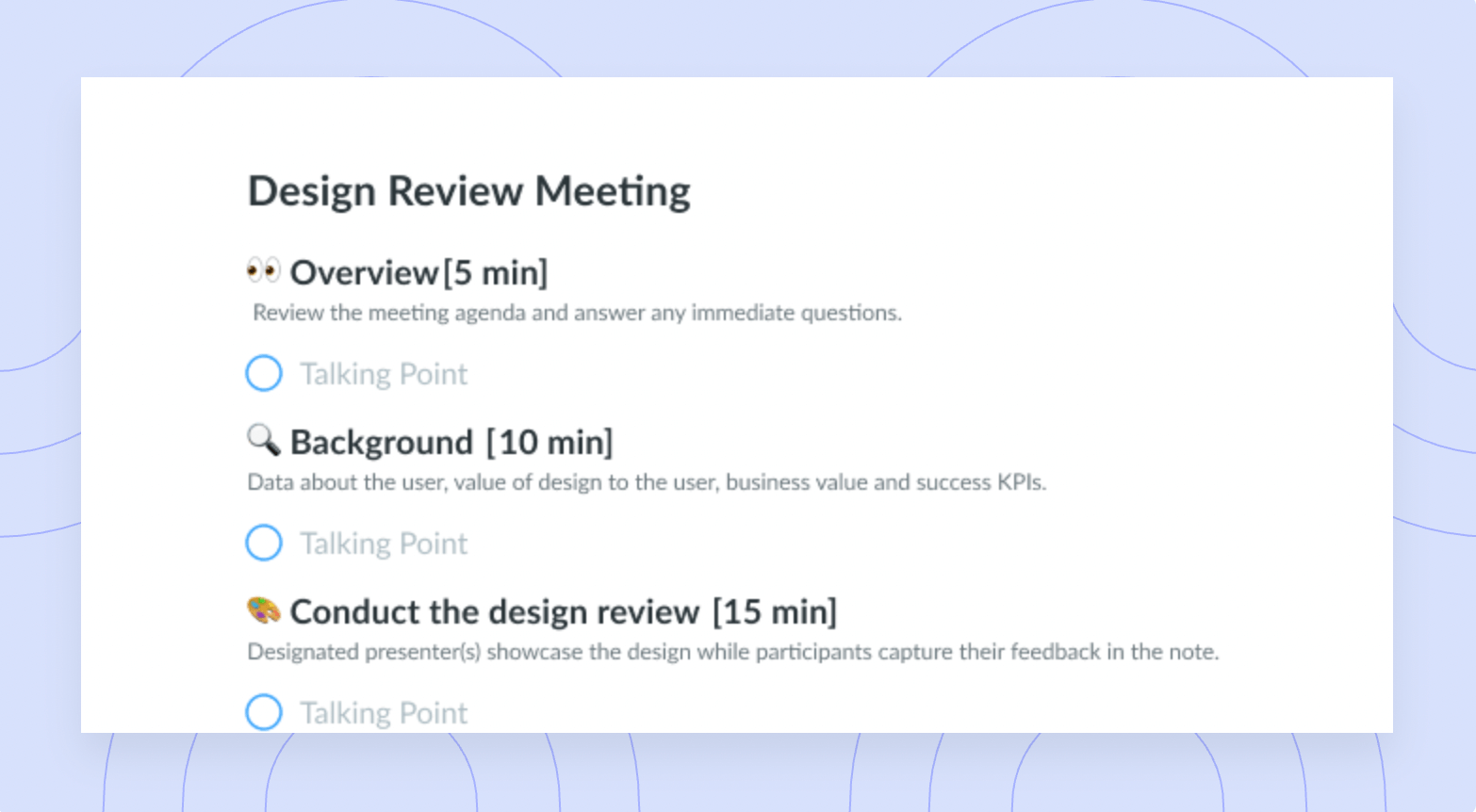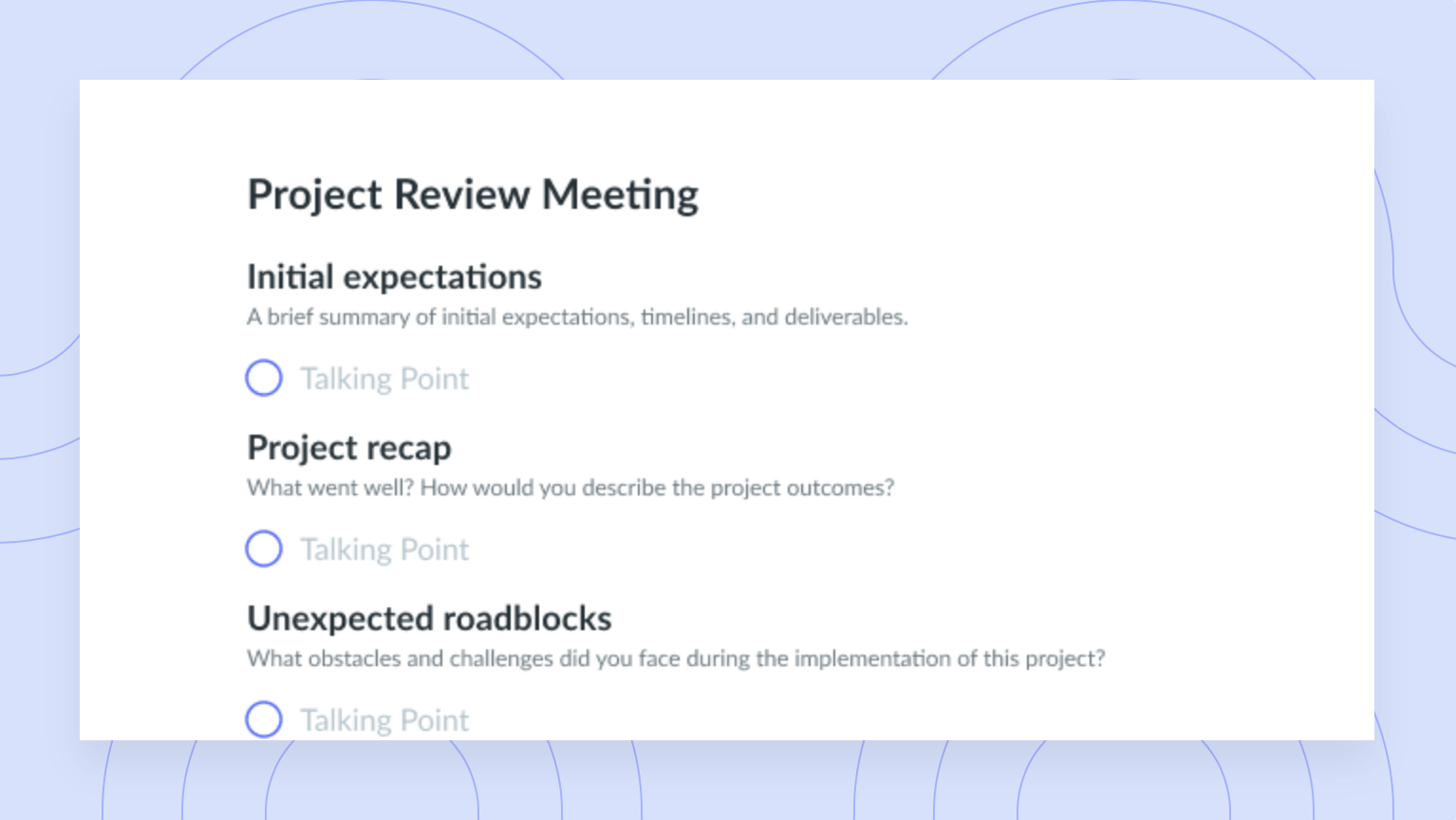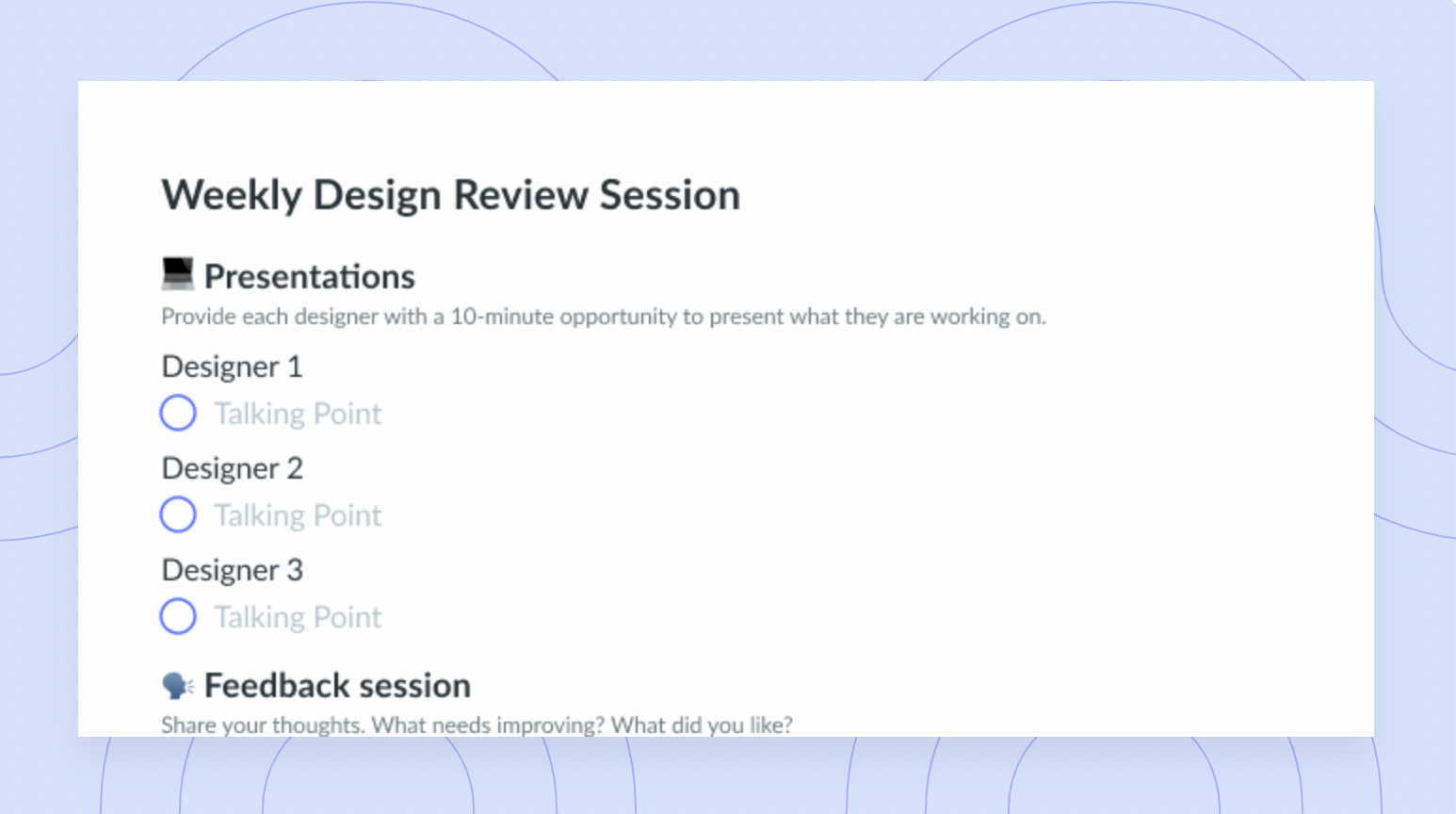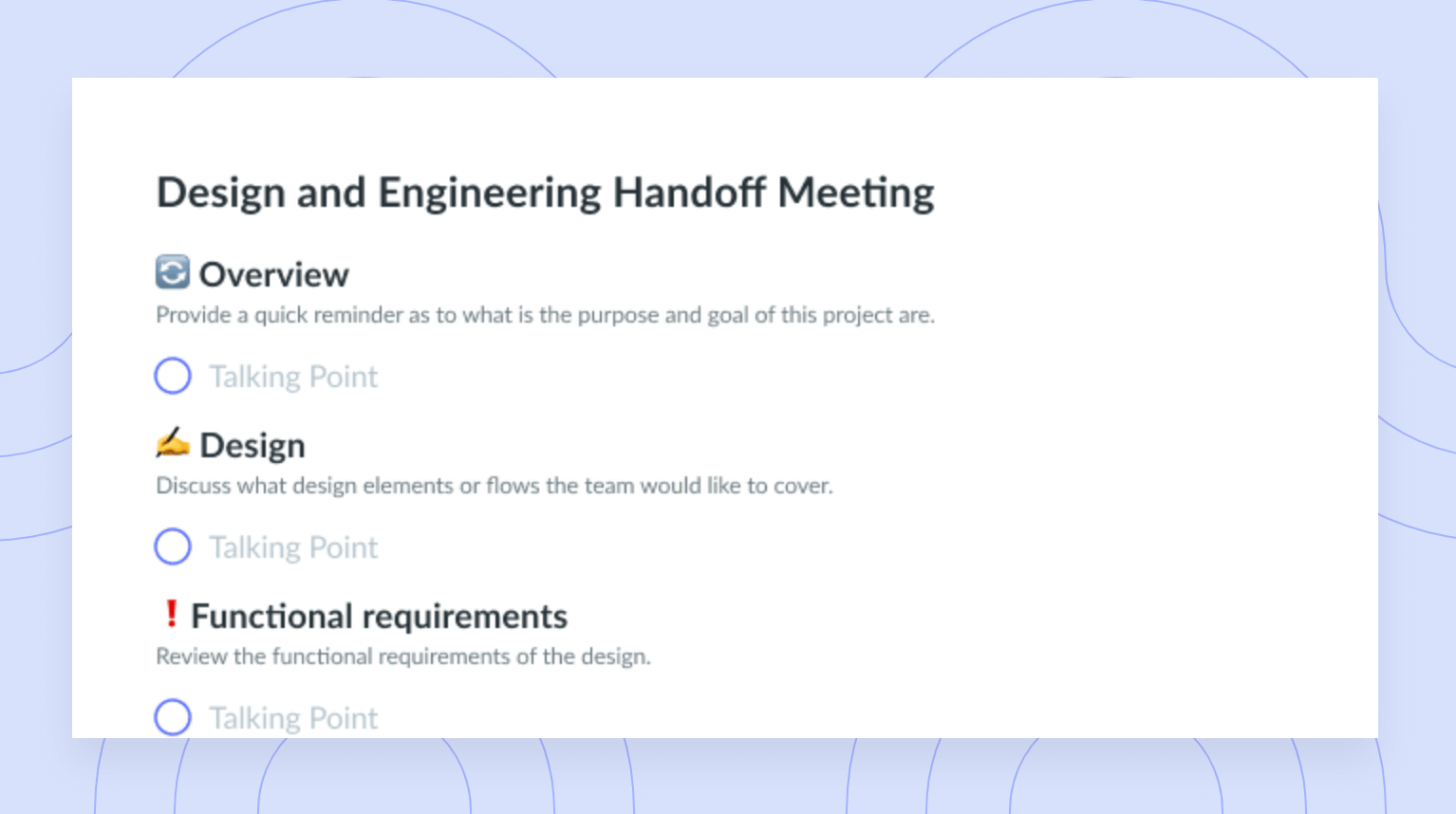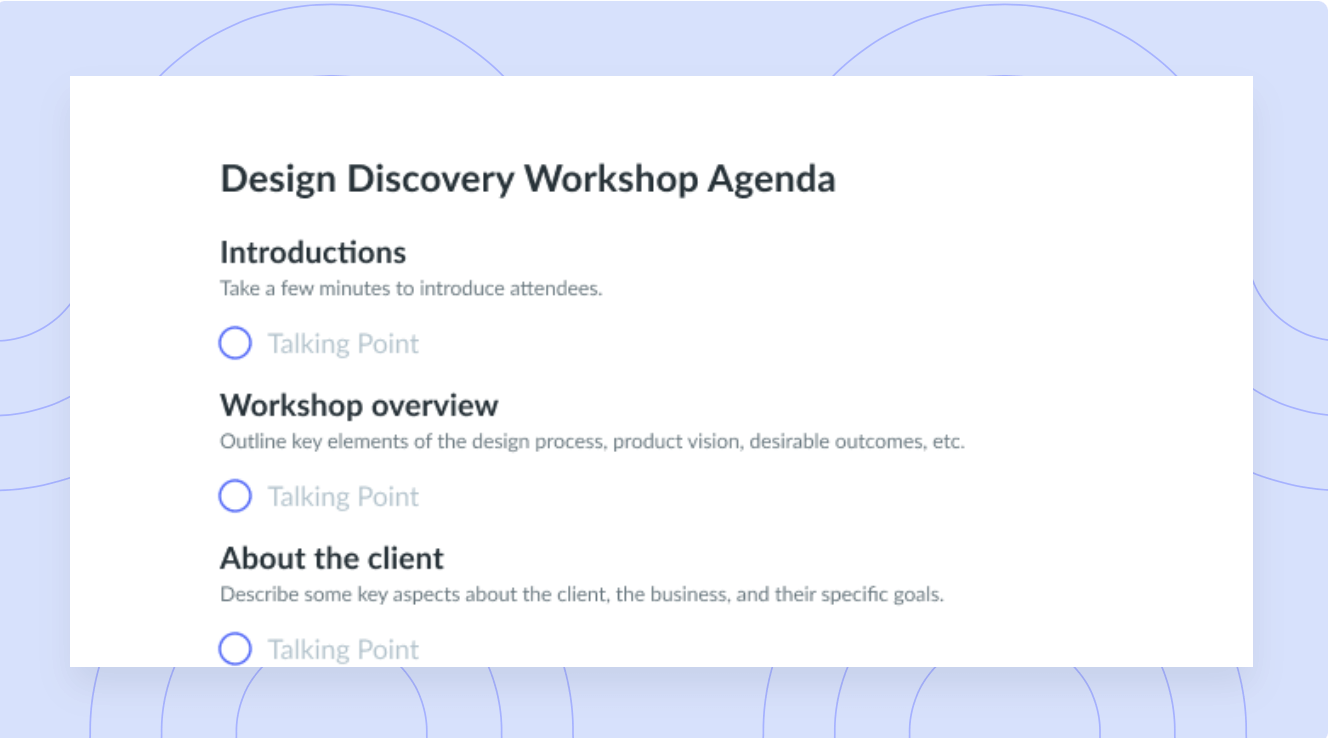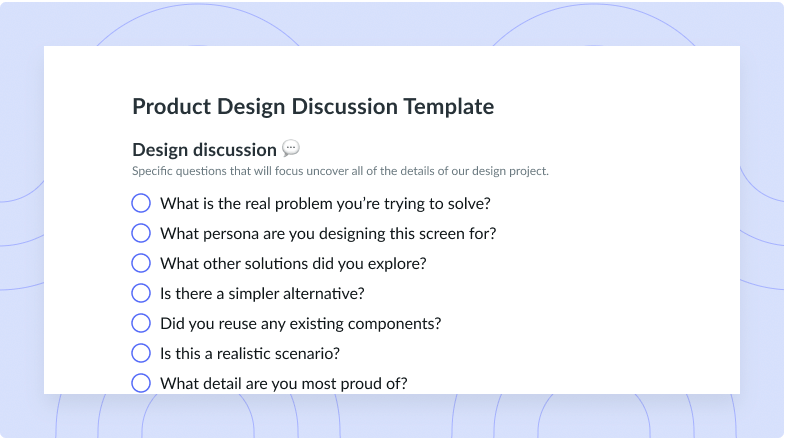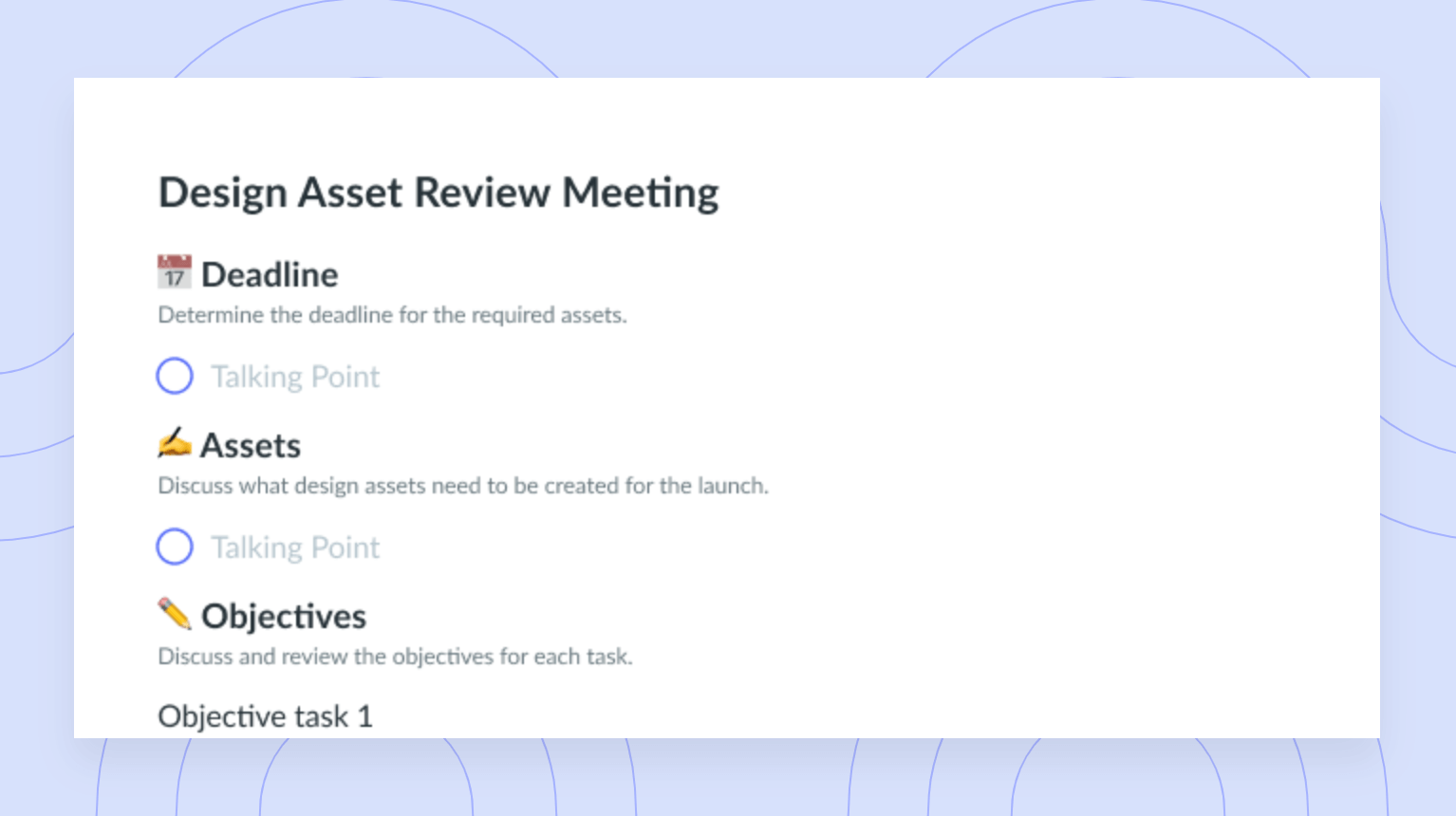The Ultimate Guide to Design Review Meetings
No design is complete without approval from several other team members. Learn what they are and how to run them in this blog post.
From an idea, to a design, to a product – that’s the flow in research and development. If it sounds simple, you probably know from experience that it’s often anything but. Really, every creative process, design included, involves so much planning, strategizing, and adjusting that your patience might run thin. And even amid all these changes, getting everyone properly aligned can be tough. Design review meetings can help.
During your design review meetings, you’ll gather all your team’s recent design work and lead in-depth discussions about its current state. Below, you’ll find everything you need to plan and run the best possible review meetings – and follow through on them after.
- What is the purpose of a design review meeting?
- What can be reviewed during a design review?
- What is the design review process?
- Different ways to run design review meetings
- What you’ll need for a design review meeting
- Design review meeting agenda template
What is the purpose of a design review meeting?
A design review meeting gives you and your team the opportunity to compare a design to all your needs and expectations. It can help you identify issues in the design before you commit time and resources to make your theoretical vision an actual product. Through this open discussion, team members can give their feedback and offer ideas for improvement on the design’s current form.

Refer back to your meeting notes anytime.
Make sure your design project runs smoothly and all voices are heard with a collaborative meeting agenda you and your team can always look back on. Try a tool like Fellow!
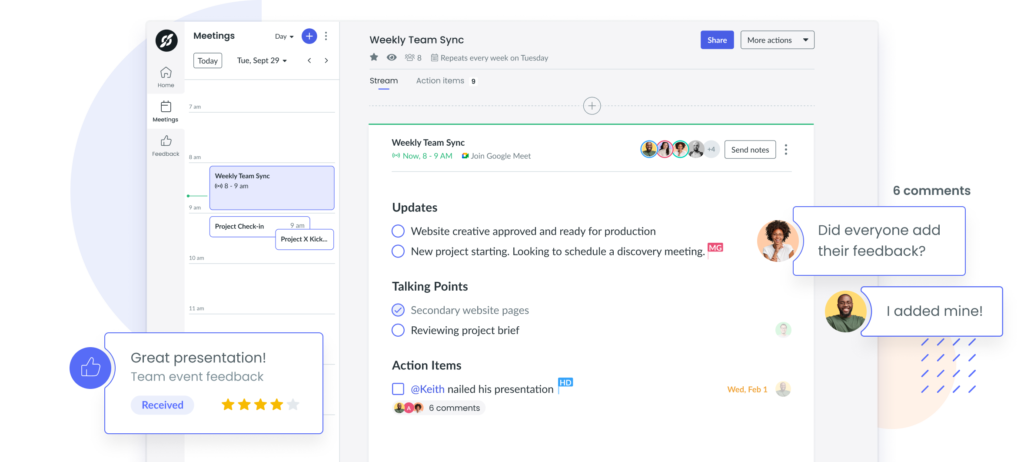
What can be reviewed during a design review meeting?
There are several types of design reviews that vary by point in the development phase, field, and product. A project manager might also want to meet with teams further removed from the design phase to receive especially unbiased, honest feedback. While there isn’t one perfect way to hold these meetings, the below guidelines should get you close.
- Design review package. The lead designer prepares this package as an overview of each design element and the project’s progress. Each design review meeting attendee should receive a copy of this document to reference during the discussion. It should include product development specifications, comparisons to similar competitor products, prototypes, and a risk analysis.
- Alternative ideas. During a design review meeting, you can assess how well your design’s current state meets your initial requirements. If any obstacles or flaws are clearly apparent, you and your team can discuss alternative ideas for completing the design while still heeding your requirements.
- Functionality. You and your team members can assess all the different design parts. This way, you’ll figure out whether the finished product can handle its intended functions and perform adequately.
- Requirements. The design you and your teams are working on presumably heeds preset requirements. During your meeting, you can assess how well your design is meeting those standards. You should base this analysis on the amount of progress your teams have made.
- Cost projections. A design review meeting shouldn’t involve altering a project’s budget or discussing it in detail – save that for the project meeting. However, your design review meeting should give you and your teams a chance to determine whether staying on budget is feasible.
- Timeline. Your design review meeting is a perfect time to assess your progress. Namely, check that everyone is working within their roles and on track to meet their deadlines. If not, it’s on you to delegate tasks as needed and do what it takes to get your deliverables out the door on time.
- Goals. Put your design’s goals back on the table to make sure your team is still following them. Doing so may initially seem needless, but bigger visions can be easy to lose sight of when tinkering with minor details. That means your team might need a reminder of what they’re working toward before you offer feedback. Once everyone is properly realigned, you can more easily work through any needed adjustments.
- Readiness. A readiness examination pertains to how well your design meets its requirements and expectations. Put another way, a design has achieved full readiness if it’s ready for testing without any revisions. And if testing goes well, production can begin.
- Final review. Yes, the prospect of production is exciting, but it can be a mistake to dive right into it – even with a product that seems ready. Take one final moment to review everything about your design, tests, and soon-to-be product. This way, you give your team one final chance to weigh in on the design before going to market. If everyone signs off on the design and its tests, you’re good to go!
What is the design review process?
Depending on the size and scope of your project, your design review process can take anywhere from a couple of hours to a few weeks. The process remains mostly the same no matter how long it takes. It also involves plentiful discussions among your team members to review the current design and assign action items that help finalize the design. A design review meeting is a great format for these discussions, and it might proceed as follows:
- Introduction
- Purpose statement
- Background
- Design presentations
- Product discussion
- Project discussion
- Prioritization and conclusion
- Post-mortem meeting
1 Introduction
There might be several teams working on a product design. As such, some folks at your meeting might not know one another. To help acclimate everyone, ask each team member to introduce themselves and state their role in the design.
2 Purpose statement
Before you dive into the bulk of your meeting, you should remind your attendees why you’re holding this review session. A meeting purpose statement can convey this point clearly and concisely. Once you put it out there, everyone present should know how to best focus their attention and feedback.
3 Background
Next, you should remind everyone of the design’s key objectives. Sure, you likely presented most of this information at the beginning of the design process, but restating it now helps properly frame your conversations. You should restate what inspired the project, name some key design requirements, and review your potential competitors.
4 Design presentations
In this part of the meeting, all team leads involved in the design process will present their own design reviews. Their reports should be thorough yet simple enough for the whole group to understand. To prompt discussion, all speakers should end their reviews with key takeaways or questions for the group to consider.
5 Product discussion
Next, everyone should discuss critical elements of the design and demonstrate any product models. You should also describe relevant testing processes and propose solutions to mitigate risk. Everyone present should have the opportunity to offer potential solutions to any concerns or unresolved issues. You all can then find answers or agree to address them at a later time.
6 Project discussion
The project manager will present updates on how the project is progressing and share project milestones. These milestones could be ones you’ve already achieved or ones likely in the near future. You should also look at your current spending versus your allocated budget and discuss how to obtain missing resources that could prove helpful.
7 Prioritization and conclusion
Take the time to provide everyone with a summary of key points or immediate action steps. You should also set aside time to resolve any open issues. If several significant issues have arisen, schedule a future meeting to go over alternate design options. Or, if your design review meeting paints an especially negative picture, you could always halt the project entirely.
8 Post-mortem meeting
Although post-mortem meetings typically follow a project’s completion, it’s never too early to start collecting notes. You can write down points from your recent discussion about ways to improve their workflows in the future. You can also note whether certain resources could make future designs easier to complete. With these ideas at hand, your post-mortem meetings will be more productive when the time comes.
Different ways to run design review meetings
There are several different types of design review meetings, and each one promotes cross-functional collaboration. In simpler terms, all design review meetings give your teams a shared understanding of the design and how everyone should move forward in its development. Below are a couple of approaches you can take during your review meeting.
1 Roundtable discussion
Roundtable discussions are common at design review meetings. They encourage free-flowing discussion while making it easier for all attendees to participate. That’s because sitting at a circular table makes it easier for everyone to see their fellow group members at all times.
Roundtables also create a close space in which everyone can feel comfortable with each other. They’re ideal if you’ve noticed certain issues in the design process and want to encourage open problem-solving discussions.
As you move through your meeting agenda, attendees can freely give their input, ask questions, and share updates. A meeting facilitator should be present to guide the group through the agenda. However, this person shouldn’t become a focal point or interfere with the natural flow of the discussion.
- Pros: Roundtable discussions allow team members to freely exchange information, collaborate on ideas, and solve problems. This way, all potential issues are out on the table. This free flow of information can also minimize the chances that attendees forget information or ideas they want to share.
- Cons: With an open roundtable format, the discussion can drift off-topic as one person piggybacks off another’s comments. Additionally, more extroverted participants might wind up dominating the discussion, as shy group members might hesitate to contribute so openly.
2 Feedback workshop
Feedback workshops often utilize feedback matrices to gather insight from all attendees. With this approach, each group member places their comments, questions, or concerns on sticky notes. They then place these sticky notes on a whiteboard for the rest of the group to see. From there, a meeting leader can review the notes and ask all attendees to share feedback on these points.
During a feedback workshop, the lead designer should present their review. While listening to the report, the rest of the group members should jot down any comments they’d like to share later in the meeting. Once the lead designer has completed their report, the discussion will open to other participants.
- Pros: A feedback workshop can bring more structure to the meeting. This way, the designer can fully complete their review before prompting discussion from the rest of the group. Using a feedback matrix also gives all attendees an equal opportunity to share their input with the group. Further, everyone can assess each others’ comments before chiming in with questions, comments, and feedback.
- Cons: Attendees must write down their comments and ideas or remember them to share when group discussion begins. This review style is also more formal and might not make attendees feel as comfortable as roundtable discussions.
What you’ll need for a design review meeting
Now that you understand what’s involved in a design review meeting and how you can hold your meeting, you’re ready to plan it. Below are some key elements you should consider as you prepare.
1 Location
Where you decide to host your meeting mainly depends on the review style you choose. If you’re holding a roundtable discussion, you’ll need to find a space large enough to hold a large circular table. If you opt for a feedback workshop, you’ll need a room with a whiteboard or another display large enough for everyone to view.
2 Participants
To get a thorough understanding of your design and its current state, you’ll need to invite people from all involved teams. However, inviting every single person who has some sort of role in the project might not be feasible. To narrow your list, start with key leaders and decision-makers. You can also ask team leads to meet with their teams in the days leading up to the meeting. This way, they can bring more comprehensive thoughts – from more people – to your meeting without crowding the room.
3 Time
The lengthy design review process and attendant discussions can make design review meetings quite time-consuming. But just as with any other meeting, a design review should have a set timeframe so the discussion doesn’t overstay its welcome. Ideally, a design review meeting should be between one and two hours.
If the design has several teams involved and could require longer discussions, consider spreading the review into a few sessions over a few days. Setting a timeframe for your meetings allows you to facilitate thorough discussion without tiring everyone out. It also respects the plentiful time attendees need to tend to their other work priorities.
4 Supplies
Although participants who are presenting reviews will bring their own models and tools to the meeting, you might want to bring some additional group supplies. You can provide pens and notepads for attendees to write down their comments and ideas during presentations. Doing so can help prevent participants from taking notes on their laptops and getting distracted by emails or other alerts. You might also need to bring sticky notes or dry-erase markers for the whiteboard if you’re holding a feedback workshop.
5 Feedback matrix
A feedback matrix is key for easily facilitating feedback workshops. Creating a matrix can be as simple as drawing an outline on the whiteboard and labeling it with terms like, “concerns,” “questions, or “critical ideas.” You can also make the labels more specific to the design’s parts to prompt discussions about certain design aspects.
6 Agenda
A proper meeting agenda is among the most important elements of an effective design review session. After all, a lot happens during design review meetings – presentations, discussions, future planning, you name it. Providing your attendees with a meeting agenda ahead of time can help them come in prepared and keep the meeting on track. Building this agenda won’t take long either if you start from a meeting agenda template.
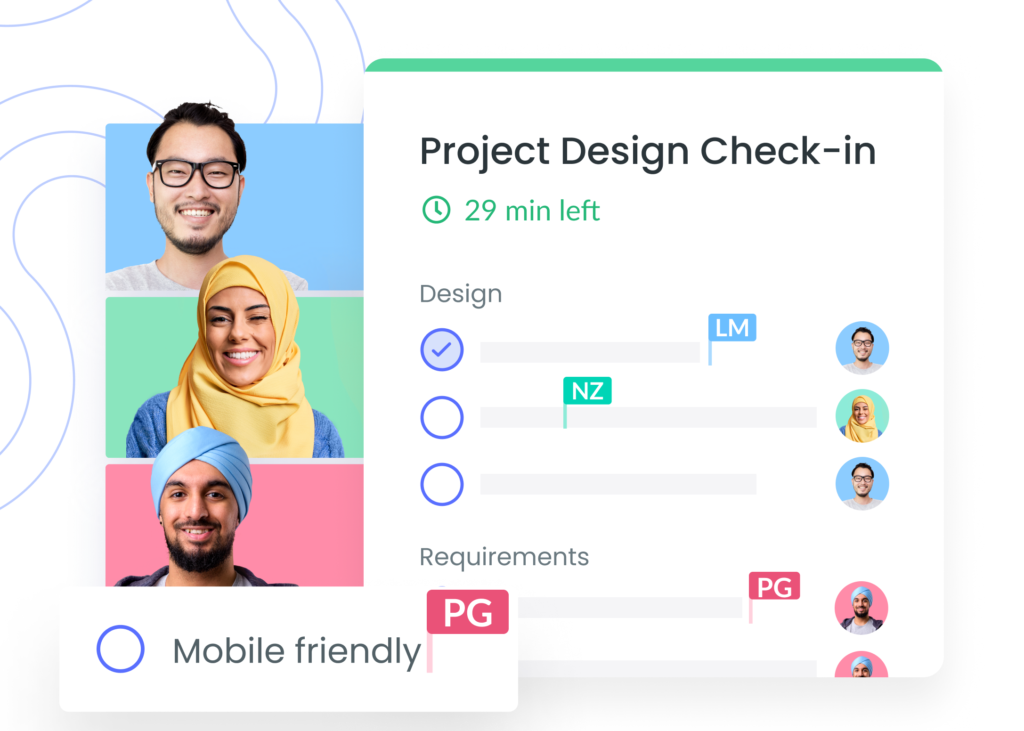
7 Design
The design is the focal point of your meeting. That means you should have it readily available at the meeting so everyone present sees it in its most updated form. You can hand out physical copies to all attendees or display a digital version on a large screen. Your goal is for everyone to see the design while the presenters are speaking and the group is discussing things.
Design review meeting agenda template
To make planning your design review meeting easier, start with Fellow’s design review meeting template. You can customize each section in this template to best resemble exactly how you’d like your meeting to flow. Under each section header will be space where you can add discussion points or key items for your presenters and other attendees to note. From your meeting’s overview to its conclusion, this template helps you set the tone for an open design review discussion. This way, your teams can find the best approach to take designs into their final form.

Getting designs one step closer to actual products
Design review meetings are key to finalizing a design that eventually leads to a successful product. They allow all the teams involved in the process to share updates and pertinent information while assessing the design in its current state. Plus, with Fellow’s tools centered around collaboration and feedback, your design review meetings will be much faster to plan and execute, not to mention – pun fully intended – productive.









